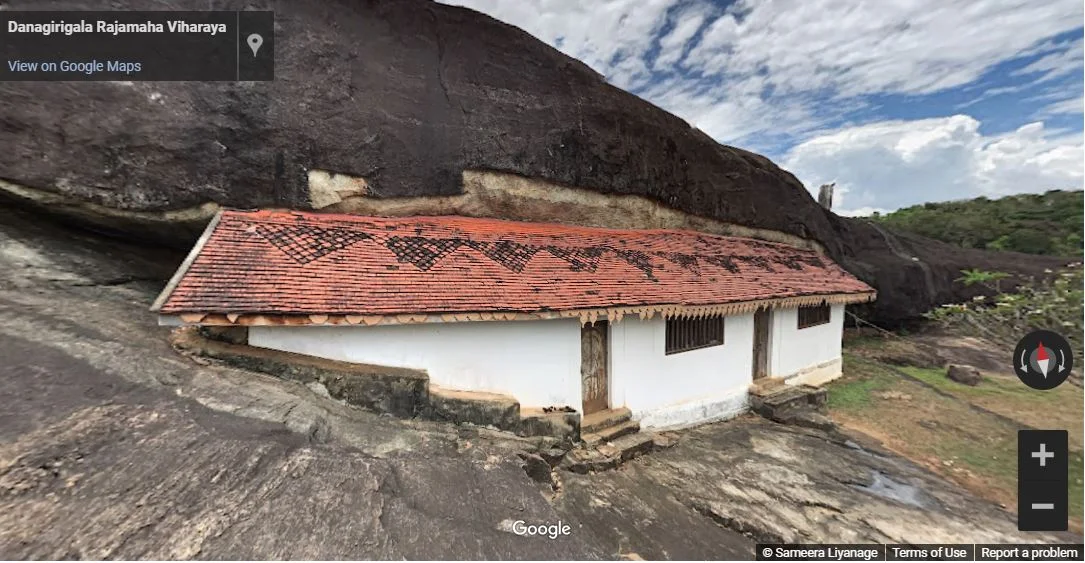
Danagirigala Viharaya (Photo credit: Sameera Liyanage, Google Street View)
Danagirigala/Danakirigala Raja Maha Viharaya (Sinhala: දනගිරිගල රජ මහා විහාරය) is a Buddhist temple in Aranayaka in Kegalle District, Sri Lanka. It is situated on a hill to the north of the famous Batalegala Rock.
History
According to local belief, Danagigigala was the ancient Vadunnagala, the residence of the mythical Naga king Chulodara [(read the story of Nagadeepa Viharaya) Abeyawardana, 2002]. Two Early Brahmi Inscriptions that have been engraved below the drip ledges of the caves at the site indicate that Danagirigala has a history running back to the pre-Christian era (Medhananda, 1984; Paranavitana, 1970).
Danagirigala cave inscription of Vessa
Period: 2nd century B.C. Script: Early Brahmi Language: Old Sinhala
Transcript: Parumaka Vesha puta parumaka Veshaha lene
Translation: The cave of the chief Vessa, son of the chief Vessa.
Citation: Paranavitana, 1970. p.61.
The hill where the Danagirigala temple is located was known as Vaddhamanakapabbata in ancient times and Egodapata, as is revealed by the copper plate grant of King Kirti Sri Rajasinha [(1747-1781 A.D.) Chutiwongs et al., 1990]. This copper plate dated 1747 and another of his successor, King Sri Rajadhi Rajasinha (1781-1798 A.D.), dated 1787 provide some historical details relating to the site (Chutiwongs et al., 1990). According to the first copper plate, the monastery at Danagirigala is dating from the time of King Valagamba [(103, 89-77 B.C.) Chutiwongs et al., 1990]. The second copper plate mainly reveals information on the images and paintings executed in the cave temple by Sri Rajadhi Rajasinha (Chutiwongs et al., 1990).
Also, the name of this temple is mentioned in Nampota, an ancient Sinhalese text which is considered to have been compiled after the 14th century A.D.
The cave temple
The upper terrace of the temple mainly consists of a Len Viharaya (cave temple) and a parapet of a Bodhi tree. Of the two, the cave temple has been built in a natural cavern in the cliff close to the summit of the rock. Although the cave had been used by the Buddhist monks since the pre-Christian era, it was excavated further during the reign of Sri Rajadhi Rajasinha as mentioned in the royal grant (Chutiwongs et al., 1990).
The murals and sculptures of the cave temple display genuine and unique features of the Kandyan art tradition of the Kandyan Period (Abeyawardana, 2002). Five Buddha images (recumbent, seated and standing), statues of deities (Vishnu and Saman) and a small Stupa are found inside the cave temple. The murals are thought to be the products of the same schools that worked at Degaldoruwa, Ridi Viharaya and Dambulla (Chutiwongs et al., 1990). The figure of Levke Disawa, the general of Kirti Sri Rajasinha with a coconut between his hands is found on the eastern side of the doorway (Chutiwongs et al., 1990).
A protected site
The ancient Danagirigala Purana Vihara situated in the Divisional Secretary’s Division of Mawanella is an archaeological protected site, declared by a government gazette notification published on 26 August 1960.

.
References
1) Abeyawardana, H.A.P., 2002. Heritage of Sabaragamuwa: Major natural, cultural and historic sites. Sabaragamuwa Development Bank and The Central Bank of Sri Lanka. ISBN: 955-575-077-7. pp.74-75.
2) Chutiwongs, N.; Prematilleke, L.; Silva, R., 1990. Sri Lanka Bithu Sithuwam: Danagirigala (Paintings of Sri Lanka: Danagirigala). Archaeological Survey of Sri Lanka: Centenary publication. Central Cultural Fund. pp.35-45.
3) Medhananda, E. 1984. Aprakata Brahmi Sellipi Ha Puravastu (In Sinhala). Sri Lanka Society of Archaeology. pp.32-33.
2) Chutiwongs, N.; Prematilleke, L.; Silva, R., 1990. Sri Lanka Bithu Sithuwam: Danagirigala (Paintings of Sri Lanka: Danagirigala). Archaeological Survey of Sri Lanka: Centenary publication. Central Cultural Fund. pp.35-45.
3) Medhananda, E. 1984. Aprakata Brahmi Sellipi Ha Puravastu (In Sinhala). Sri Lanka Society of Archaeology. pp.32-33.
4) Paranavitana, S., 1970. Inscriptions of Ceylon: Volume I: Early Brahmi Inscriptions. Department of Archaeology Ceylon. p.61.
5) The government Gazette notification, no: 12186. 26 August 1960.
Location Map
This page was last updated on 22 July 2023

